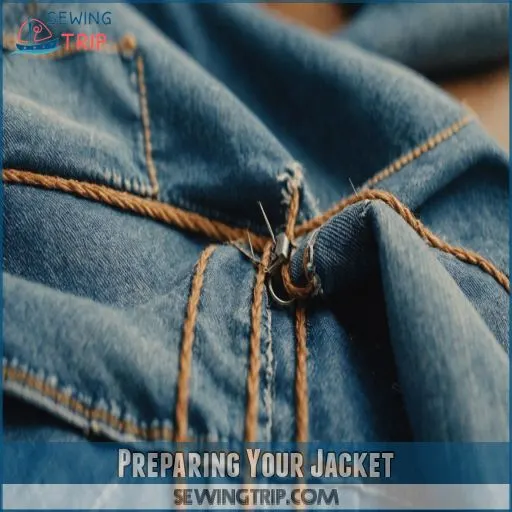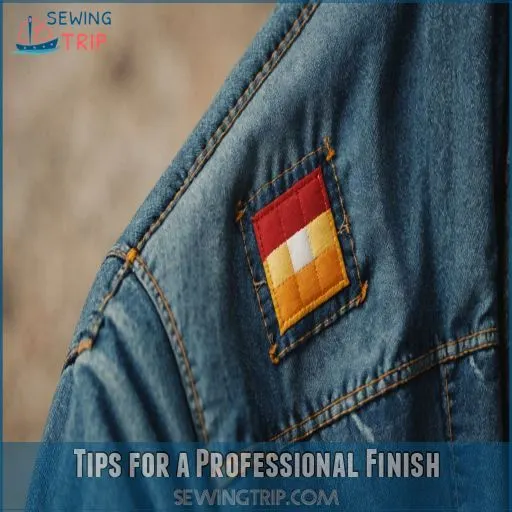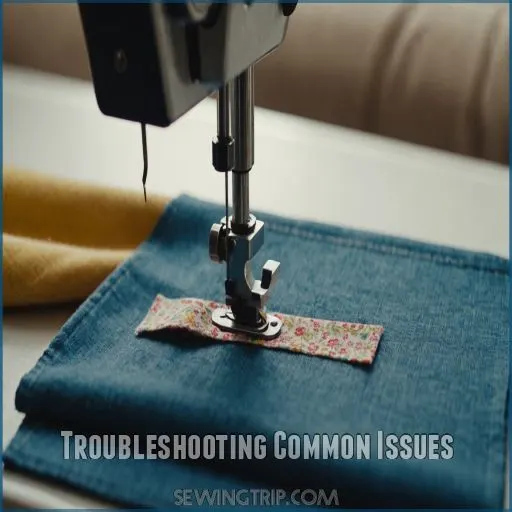This site is supported by our readers. We may earn a commission, at no cost to you, if you purchase through links.
 Sewing a patch onto your jacket is a breeze once you know the tricks!
Sewing a patch onto your jacket is a breeze once you know the tricks!
First, choose a durable patch that complements your jacket’s style.
Then, prep the area by giving your jacket a quick wash and iron.
Use pins to experiment with placement – you want the patch to look balanced and intentional.
When you’re ready, thread your needle and get to stitching.
Take it slow, using small, even stitches to secure the patch.
For extra durability, you can also try machine-sewing or using iron-on hem tape.
Just be careful not to pull the thread too tight and pucker the fabric.
Once you’ve sewn it on, your patched jacket will be the talk of the town!
Table Of Contents
- Key Takeaways
- Choosing the Right Patches
- Preparing Your Jacket
- Planning Patch Placement
- Hand-Sewing Techniques
- Machine-Sewing Techniques
- Tips for a Professional Finish
- Sewing on Your Patch
- Caring for Your Patched Jacket
- Alternative Methods for Attaching Patches
- Troubleshooting Common Issues
- Frequently Asked Questions (FAQs)
- Conclusion
Key Takeaways
- Choose high-quality, durable patches that complement your jacket’s style and theme. Experiment with placement using pins to achieve the perfect balance and visual harmony.
- Prep your jacket by giving it a quick wash and iron to create a clean, smooth canvas for your patch. Gather essential sewing supplies like thread, needles, and pins to make the process a breeze, like investing in high-quality sewing tools.
- Whether you hand-sew or machine-sew, take it slow and use small, even stitches to securely attach the patch. For extra durability, try techniques like backstitching, reinforcing stitches, or using iron-on hem tape.
- Caring for your patched jacket is key – avoid frequent washing, spot clean stains, and store it properly to keep your patches looking fresh. Inspect for wear and tear over time and make repairs as needed.
Choosing the Right Patches
When you’re picking the patches for your jacket, think about quality and style to make it uniquely yours.
From bold dragons to subtle floral designs, there’s a patch for every taste, and your jacket shouldn’t be left out of the fun.
Patch Materials and Quality
When choosing patches for your jacket, be sure to invest in high-quality materials that will stand the test of time. Look for patches made from durable fabrics like embroidered cotton, leather, or vinyl.
Consider the patch’s longevity – will it hold up to regular wear and tear?
Opt for patches with reinforced edges and sturdy stitching for maximum durability.
- Embroidered fabric patches
- Leather or vinyl patches
- Patches with reinforced edges
Considerations for Patch Size and Shape
Choosing the right patch size and shape can really amp up your jacket’s style.
Think of it as selecting the perfect puzzle piece—but for fashion!
Too big, and it may overwhelm your look; too small, and it might get lost.
Make sure it complements your personal style and theme while placing it strategically for maximum visual appeal.
Aesthetic and Thematic Considerations
You’ve got a jacket prepped and ready, now think theme! Maybe it’s a vintage French flair a rugged military uniform vibe.
Patches are your finishing touches—your badge of style and stories.
Pick colors and designs that echo your personal preference and aesthetic.
After all, it’s not just a jacket; it’s your wearable scrapbook.
Where to Find Patches for Clothes
Falling in love with a patch’s aesthetic is just the start.
Hunt for treasures at online retailers, Etsy shops, or your local craft and vintage stores.
Stroll through local markets, too; they’re a goldmine! Joann Fabric often has fabulous finds.
Whether using a sewing machine or hand sewing, your jacket’s transformation begins with finding the perfect patch.
How to Choose the Perfect Patch for Your Jacket
Elevate your jacket’s style by selecting the perfect patch!
Consider the theme or aesthetic you’re going for, then choose a size that complements your jacket.
Quality matters – invest in well-made patches that will stand the test of time.
Experiment with placement, using pins to visualize where the patch will shine.
With the right patch, your jacket will be a true showstopper!
Preparing Your Jacket
Before you start sewing patches on your jacket, make sure it’s clean enough to eat off—though we’re just sewing, not dining!
Gather all your supplies, from trusty thread and needles to those lifesaving safety pins, because a well-prepared patch job is half the battle won.
Cleaning the Jacket Before Patching
Now that you’ve nailed down the right patches, let’s prep that jacket! Start with a pre-wash to tackle any hidden surprises or pesky stains. Different fabrics need different TLC, so check the label for drying methods. After washing, grab your ironing board and smooth out wrinkles on low heat. Remember, your patch deserves a clean, smooth canvas!
- Always pre-wash for stain removal
- Match fabric type to drying method
- Use low heat for ironing
Gathering Essential Supplies for Patching
With your jacket spick and span, let’s gather the patching tools needed to nail this fashion game. Grab thread that matches or pops, a suitable needle, scissors, and those trusty pins. Throw in some iron-on supplies and fabric glue for added zing.
| Tool | Purpose |
|---|---|
| Thread | To sew the patch securely |
| Needles | For hand or machine sewing |
| Pins | To hold the patch in place |
| Fabric Glue | For extra durability |
This toolkit makes sure you’re ready to create a masterpiece!
Using Pins to Plan Patch Placement
Once you’ve gathered your patches, use pins to play around with different placement options on your jacket.
Experiment with symmetry, balance, and aesthetics to find the perfect spot.
Pinning the patches in place first allows you to easily adjust and rearrange until you achieve the look you envisioned.
Take your time – the right placement can make all the difference!
Choosing Thread and Needle for Patching
Thread and needle are your trusty sidekicks in this patching adventure.
Choose thread weight and color that matches or boldly contrasts with the jacket.
Opt for a needle size suitable for your fabric type and patch material, checking needle recommendations.
Want stitches that won’t quit? Go for durability—polyester’s got your back, while cotton threads whisper elegance.
Ready, set, stitch!
Ironing the Jacket to Remove Wrinkles
Why iron the jacket first? It’s all about putting your best foot forward.
Properly prepped fabric, whether wrinkle-resistant or not, sets the stage.
Place your jacket flat on your ironing board—steam or dry heat gets the job done.
Don’t forget: follow fabric care instructions, especially with delicate threads.
Think of it like priming a canvas before a masterpiece.
Planning Patch Placement
When you’re planning patch placement on your jacket, it’s like playing dress-up for grown-ups with a touch of creativity.
Your aim is to balance the patch sizes and locations to create a cohesive and eye-catching design on the front, back, or even the sleeves—just don’t forget to let your unique flair shine through!
Considering the Size and Placement of Patches
When choosing patches for your jacket, consider how the size of the patch will complement the overall look and feel of your garment. Larger patches may overwhelm a smaller jacket, while smaller patches may get lost on a bulkier style.
Play around with placement using pins to visualize the perfect balance and design.
- Patch size in relation to jacket
- Aesthetic and thematic considerations
- Placement options on front, back, sleeves
- Visualizing the final look with pins
- Ensuring visual balance and harmony
Choosing the Front, Back, or Sleeve Placement
You’ve picked the perfect patch and size, so let’s talk about where to put it.
Think of your jacket as a canvas.
Will the front make a bold statement?
Maybe the sleeves add a touch of symmetry.
How about a back design for drama?
Play with contrast placement to balance style and function.
Your jacket’s design is yours to craft!
Visualizing the Final Look and Making Adjustments
Visualizing your jacket’s style narrative helps create the perfect patch placement! Consider these bold moves:
- Patch placement: Mix and match spots to find what complements the jacket.
- Color scheme: Make sure there’s harmony or daring contrast with existing hues.
- Patch size: Balance large and small for visual intrigue.
- Overall look: Adjust until the jacket tells its story stylishly!
Happy sewing adventures!
Measuring and Marking Patch Placement
Mapping out your patch placement is like arranging a garden. Keep things balanced and let your creativity bloom.
| Patch Placement | Emotion Evoked |
|---|---|
| Front Breast | Confidence |
| Sleeve Accent | Adventurous Spirit |
| Back Center | Bold Statement |
| Shoulder Edge | Subtle Elegance |
Ensure symmetrical designs by using a measuring tape for accuracy, and mark lightly with chalk.
Using Iron-on Hem Tape for Larger Patches
For larger patches, iron-on hem tape can be a game-changer.
Simply cut the tape to size, position it behind the patch, and use a hot iron to fuse it in place.
This creates a sturdy, low-profile bond that holds the patch securely without the need for extensive sewing.
Just be mindful of the patch size – too large and the tape may not provide enough support.
Hand-Sewing Techniques
Hand-sewing a patch onto your jacket is both an art and a science, bringing vintage charm to your ensemble.
Grab your needle, channel your inner crafting maestro, and get ready to stitch with precision and a touch of flair.
Threading the Needle and Tying a Knot
To start sewing, grab your trusty needle. Use a length of thread suitable for the jacket’s fabric and color. Is thread thickness keeping you awake at night? Go for sturdy! threading a needle might feel like threading a camel through an eye at times. Finish with a reliable knot, embracing the art of hand sewing:
| Needle Types | Thread Thickness | Thread Color | Knot Techniques | Hand vs. Machine |
|---|---|---|---|---|
| Embroidery | Thick | Match | Double | Hand |
| Universal | Medium | Contrast | Loop | Machine |
| Quilting | Thin | Blend | Single | Hand |
| Heavy-duty | Varies | Complement | Triple | Machine |
| Curved | Adjustable | Neutral | Overhand | Combo |
Securing the Patch With Pins
Once your needle’s threaded, it’s time for a tiny workout—a pinning session! Think of pin placement like choreography; you’re guiding your patch to its debut spot on the jacket stage.
Choose the right pin types to secure the fabric without causing a tutu full of holes.
Remember: when the patch is aligned perfectly, it’s a standing ovation waiting to happen.
Starting the Sewing Process
Now that your patch is securely pinned in place, it’s time to start sewing. Thread your needle and tie a knot at the end of the thread. Gently insert the needle through the back of the patch, pulling it through until the knot stops at the patch’s surface. You’re ready to start stitching!
- Use small, even stitches for the best results.
- Avoid pulling the thread too tightly, which can cause puckering.
- Backstitch at the beginning and end to reinforce the stitches.
Stitching Around the Patch Edge
Grabbing your needle and matching thread, begin stitching near the patch’s edge.
Keep your stitch size consistent for good stitch quality.
A simple running stitch can do the trick, but be mindful of your thread tension.
If it’s too tight, you’ll pucker like a raisin! It’s all about finding a balance—like walking a tightrope!
Happy stitching!
Using Decorative Stitches for Embellishment
Embroidering your patch with decorative stitches is like dressing sprinkles on top of a cupcake—it adds that extra flair!
Consider using stitches such as a blanket stitch or a catch stitch for delightful edges.
Play with thread colors to match your patch designs.
Hand vs. machine stitching? Choose whichever suits your style and patch theme!
Machine-Sewing Techniques
Now that you’ve gathered your materials, it’s time to tackle the sewing machine for a polished patch finish.
Remember, even the best machines can’t fix a poorly threaded bobbin—trust me, it’s sewing’s version of a "check engine" light!
Preparing the Sewing Machine
First, set up your sewing machine by threading the needle and winding the bobbin with a matching color thread.
Adjust the tension and stitch length to suit your fabric and patch thickness.
Don’t forget to lower the presser foot – this will help keep your patch in place as you sew.
With your machine ready, you’re all set to start stitching!
Using the Straight Stitch or Zigzag Stitch
Okay, how ready are you to stitch like a pro?
Set your machine to either a straight stitch for precision or a zigzag stitch for stronger hold.
Adjust stitch length and tension control, ensuring the needle type and thread choice suit your fabric.
Don’t rush, follow the stitch direction smoothly, keeping it consistent—you’re sewing with style!
Backstitching for Reinforcement
You’ve started stitching, and now it’s time to reinforce with backstitching. Think of it as the belt and suspenders of patch sewing! It makes your seams stronger.
- Shorten your backstitch length for stronger seams.
- Check stitch density for even tension.
- Match thread weight to fabric thickness.
- Choose the appropriate needle type.
Make backstitching your trusty sidekick!
Tips for a Professional Finish
In this section, you’ll discover the secrets to making your patches look like they were sewn by a pro.
Grab a thimble, choose a strong thread, and prep for some satisfying reinforcement—you’ll be wanting to iron the patch to perfection!
Using a Thimble for Thick Fabrics
When working with thick fabrics or multiple layers, a thimble can be a game-changer.
It helps you push the needle through with ease, protecting your fingers from soreness and fatigue.
Plus, it gives you better control over your stitches for a polished, professional finish.
Don’t be afraid to give it a try – your hands will thank you!
| Fabric Thickness | Thimble Benefit |
|---|---|
| Light | Minimal |
| Medium | Moderate |
| Heavy | Significant |
Choosing Strong and Durable Thread
What’s the secret to a patch that stays put? Selecting strong, durable thread types is your ticket! Polyester or nylon threads pack a punch in thread strength, ideal for long-lasting patches.
Pick a thread color that complements or contrasts for style points—just avoid the rainbow unless that’s your theme!
Mind thread thickness; balance is key for flexibility.
Reinforcing Stitches for Durability
To make sure your patch lasts, pay attention to stitch density and length.
A backstitching technique adds knot strength, like the backbone of sewing.
Choose a sturdy thread type that matches your jacket’s needs.
Remember, a reinforced stitch is like a safety net for your patch, preventing any sneaky escapes when embracing life’s adventures!
Ironing the Patch for a Smooth Finish
Ironing your patch helps achieve a polished, smooth finish, but, remember, it’s a delicate dance with heat-sensitive patches. Make sure the ironing temperature is low, and check your steam settings—no one wants a steamed spinach smell with their jacket!
Use a clean cloth to protect fabric compatibility and employ gentle pressing techniques.
- Use low heat
- Protect with cloth
- Watch for steam
- Press gently
Using Interfacing for Added Sturdiness
For an extra layer of stability and support, consider using interfacing on the backside of your patch.
This sturdy fabric reinforcement can help prevent the patch from warping or bowing over time.
Simply cut a piece of interfacing to match the size of your patch and iron it on before sewing.
This added step makes sure your patched jacket looks polished and professional.
Sewing on Your Patch
You’ve chosen your patches, prepped your jacket, and now it’s time for the fun part—sewing those patches on!
Don’t worry; even if your hand sewing isn’t exactly couture, a running stitch or blanket stitch will securely and beautifully attach your patch, and no one will be any the wiser if you enjoy the process.
Using the Running Stitch or Blanket Stitch
While adding flair to your jacket, don’t overlook the running stitch or blanket stitch!
These stitch variations give your patch personality.
Keep stitch length consistent for elegance.
Control stitch tension—too tight may wrinkle, too loose invites disaster!
Your hands, stitching tools of creativity, master stitch placement.
Just like a well-told tale, each stitch tells its own part of the story.
Sewing Around the Patch Edge
Once you’re all set, start sewing around the patch edge. Whether you’re using a needle for hand stitching or the precision of a machine, make sure stitch types and lengths are just right. Remember, the thread color should complement your masterpiece.
- Feel the magic of creation
- Transform your jacket
- Grace every stitch
- Conquer techniques with flair
Trimming Excess Threads
Once you’ve finished sewing around the patch, it’s time to trim away any excess threads.
Grab a sharp pair of scissors and snip the threads close to the fabric, being careful not to cut into the patch or jacket itself.
This will give your patched jacket a clean, professional finish.
Take your time and control the thread length for the best results.
Inspecting the Final Work
You’ve snipped those threads, and now it’s time to give your masterpiece a once-over.
Look for any uneven stitching and patch misalignment.
- Patch security: Tug gently to make sure it’s firmly attached.
- Overall look: Step back and admire how the patch complements the jacket.
- Thread quality: Make sure no frayed threads are sticking out.
Consider it your jacket’s TLC moment!
Caring for Your Patched Jacket
Now that you’ve beautifully adorned your jacket with patches, let’s keep it looking its best without turning it into a laundry martyr.
A little care will make sure those patches stay put and look fabulous, so save the frequent washing for your gym clothes!
Washing and Drying Instructions
For your patched jacket’s longevity, embrace gentle wash cycles like a protective parent.
Use cold water and mild detergent to prevent shrinking.
Dry it flat, avoiding tumble dryers that delight in unraveling your creations.
If stains invade, spot treat those rebel areas with kindness, not harsh chemicals.
Remember, patience in patch care is worth the effort for style’s sake!
Avoiding Frequent Washing and Wear
Avoid washing your patched jacket too frequently to prevent wear and tear on the patches.
Those carefully sewn-on badges and emblems won’t last forever, so treat your jacket with care.
Spot clean any stains instead of machine washing – this will help preserve the integrity of the patches and keep your jacket looking sharp for longer.
Hand Washing or Spot Cleaning Stains
For caring for your patched jacket, hand washing or spot cleaning is a friendly alternative to tossing it in the washer.
Stain removal tips include treating common culprits like ketchup or mud right away.
Use gentle cleaning products, like mild detergent.
Try entertaining your cat while waiting for it to dry naturally—it’s a real multitasking feat!
- Dab stains gently.
- Use cold water.
- Test products first.
- Pat dry with a towel.
Storing the Jacket to Prevent Damage
Proper jacket storage is key to keeping your masterpiece looking sharp.
Hang it on a sturdy hanger to maintain its shape.
Moth prevention is crucial to preserving your garment. Like a moth to a flame (or fabric), those pesky critters love closets, so toss in some cedar balls for moth prevention.
Control humidity levels to avoid dampness, ensuring fabric preservation and longevity.
Your jacket’s future self will thank you!
Inspecting the Patches for Wear
Over time, your jacket’s patches might face some wear and tear. Don’t let ’em pull the wool over your eyes! Grab a critical eye and inspect for:
- Fading or color changes.
- Fraying edges or loose stitching.
- Thread wear.
Catch these early, and you’ll dodge a sewing saga longer than your favorite TV series!
Alternative Methods for Attaching Patches
While sewing on patches can be a straightforward process, there are alternative methods that can make the job even easier.
From iron-on patches to fabric glue, these quick techniques can help you add a personal touch to your jacket without the hassle of hand-stitching.
Using Iron-on Patches and Hem Tape
After caring for your patched jacket, consider easy alternatives like iron-on patches and hem tape.
They’re the fast-pass lane to patch durability.
Simply place your patch, cover with a cloth, and press with low heat—bam, you’re stuck!
No more needle wrestling or stitch battles.
Experiment with placement for that flawless finish, and your jacket’s good as new.
Using Fabric Glue and Ironing
If iron-on patches aren’t your cup of tea, fabric glue’s your ticket.
Picture it: You’re a crafting wizard applying glue perfectly.
Make sure the glue suits the fabric type, then, like a magic spell, press with a low-heat iron!
Allow it to dry – patience is key here!
For better results, dream up alternatives like interfacing or glue sticks.
Using Pins and Tacking Stitches
Stick around, and let’s tackle using pins and tacking stitches.
Pin placement is a breeze—place your patch where you want it, and pin it down.
Use a simple tacking technique to secure it:
- Choose a stitch type that matches your fabric type.
- Make sure the patch is secure before sewing.
- Laugh off any pricks—safety first!
Using Interfacing for Added Support
For extra reinforcement, consider using interfacing behind your patch.
This sturdy fabric backing will help the patch hold its shape and prevent puckering or distortion over time.
Just be sure to choose an interfacing that’s compatible with your jacket material – a lightweight woven for delicate fabrics, or a heavier fusible for thicker coats.
A little interfacing can go a long way in creating a polished, professional-looking patch.
Troubleshooting Common Issues
Even with the best effort, patches can sometimes wrinkle, detach, or just not look right on your jacket.
Don’t worry, we’ve got simple solutions to tackle these common patch problems and get your jacket back to looking its best, no superpowers required!
Dealing With Wrinkled or Puckered Patches
Sometimes a patch throws a wrinkle party. Keep calm and iron on! Call on steam to flatter your patch’s ego.
- Check patch tension, so it’s not too tight or loose.
- Understand fabric type—delicate fabrics need gentler handling.
- Apply steady, even pressure when ironing.
- Iron from the backside for best results.
- Avoid stitching mistakes by using consistent techniques.
Fixing Loose or Detached Patches
Wrinkled patches got you down? Fix loose or detached patches with strong thread or adhesive! Don’t let them dangle like a loose tooth—secure them with fresh stitches. Use a steady hand and a good sense of humor to tackle this with confidence. Here’s a quick guide to set you back on track:
| Problem | Solution | Prevention Tip |
|---|---|---|
| Loose stitching | Reinforce with new thread | Double-stitch initially |
| Peeling edges | Use fabric glue | Check adhesive quality |
| Frequent washing | Hand wash preferred | Reduce wash frequency |
| Heavy patches | Add extra stitches | Use lighter patches |
| Slippery fabric | Use pins to stabilize | Pre-wash or starch |
Here’s a quick guide to set you back on track:
Removing Excess Thread or Stitches
If you’ve got excess thread or stitches hanging around, don’t fret!
Carefully snip them off with sharp scissors, taking care not to cut into the fabric.
This will give your patched jacket a clean, professional look.
Just be gentle and take your time – you don’t want to accidentally create any new holes or tears.
Adjusting Patch Placement for Better Fit
How on earth does one achieve the perfect patch alignment?
Make sure you have visual harmony and jacket balance by reevaluating your patch placement.
Use pins to move patches until they complement your jacket’s design.
Keep the patch size proportional to the jacket dimensions.
Think of it as a jigsaw puzzle—trial and error will lead you to the right fit!
Repairing Damaged or Torn Fabric
Accidents happen, and tears are just the fabric’s way of adding character.
Start by trimming any frayed edges.
Slide a patch or same-colored fabric under the hole.
Use your preferred stitch—running, blanket, or zigzag—to secure it.
For best results, practice these DIY patching techniques, giving your jacket a second wind.
After all, nobody needs to know about that tree branch mishap!
Frequently Asked Questions (FAQs)
How to sew patches on to jacket?
Think of your jacket as a blank canvas!
First, secure your patch using pins.
Then, stitch like painting—use a needle and thread to trace the edges.
How to sew on a patch for beginners?
When sewing a patch onto a jacket, make sure your jacket’s cleaned, and the patch’s positioned nicely.
Select a sturdy needle and thread; secure the patch with pins, and sew small stitches along the edge for a snazzy finish.
What is the best stitch to sew on a patch?
Like a seasoned tailor, the best stitch to sew on a patch is a sturdy zigzag or a neat blanket stitch – they’ll hold your patch in place like a trusty sidekick.
How to attach a patch without sewing?
Want to attach a patch without sewing?
Grab an iron-on patch, place it on your jacket, and use a hot iron to adhere it.
For extra security, add fabric glue around the edges before ironing.
How to remove a patch without damaging fabric?
Removing a patch is like peeling a stubborn sticker: patiently apply heat with an iron on low to soften any adhesive.
Then, gently lift with a seam ripper.
Avoid tugging to prevent tearing your fabric masterpiece.
Can patches be reused on different garments?
Yes, patches can be reused!
Attach them using velcro or adhesive backing for easy swapping.
These methods keep your garment fabric unharmed, offering the freedom to change themes or styles without sewing hassle (Source).
Are patches suitable for waterproof materials?
For waterproof materials, patches can be a tricky business.
However, with the right know-how and a bit of elbow grease, you can make it work like a charm.
The key is to choose your patch wisely and follow the instructions to a tee.
What type of stitch should be used for leather?
Sewing a patch onto leather gives you a rockstar vibe, doesn’t it?
Use a leather needle and a strong polyester thread.
Opt for a saddle stitch—looping back provides durability and a polished look.
Happy stitching!
How can embroidery be added to patches?
Spice up your patches with embroidery by sketching a design on stabilizer.
Secure it with temporary adhesive spray, stitch the pattern, and remove the stabilizer.
It adds that "wow" factor, turning your patches into masterpieces!
Conclusion
You’ve got this down pat! Now that you’ve navigated the ins and outs of how to sew a patch on a jacket, your creativity can really shine. Whether hand-sewing or using a machine, with practice, you’ll master the art, impressing friends with your personalized flair.
Remember, stitch by stitch, you’re not just securing fabric but crafting a story.
So, grab your needle, embrace the challenge, and wear your masterpiece proudly. Happy patching, and may your jacket be the talk of the town!
















